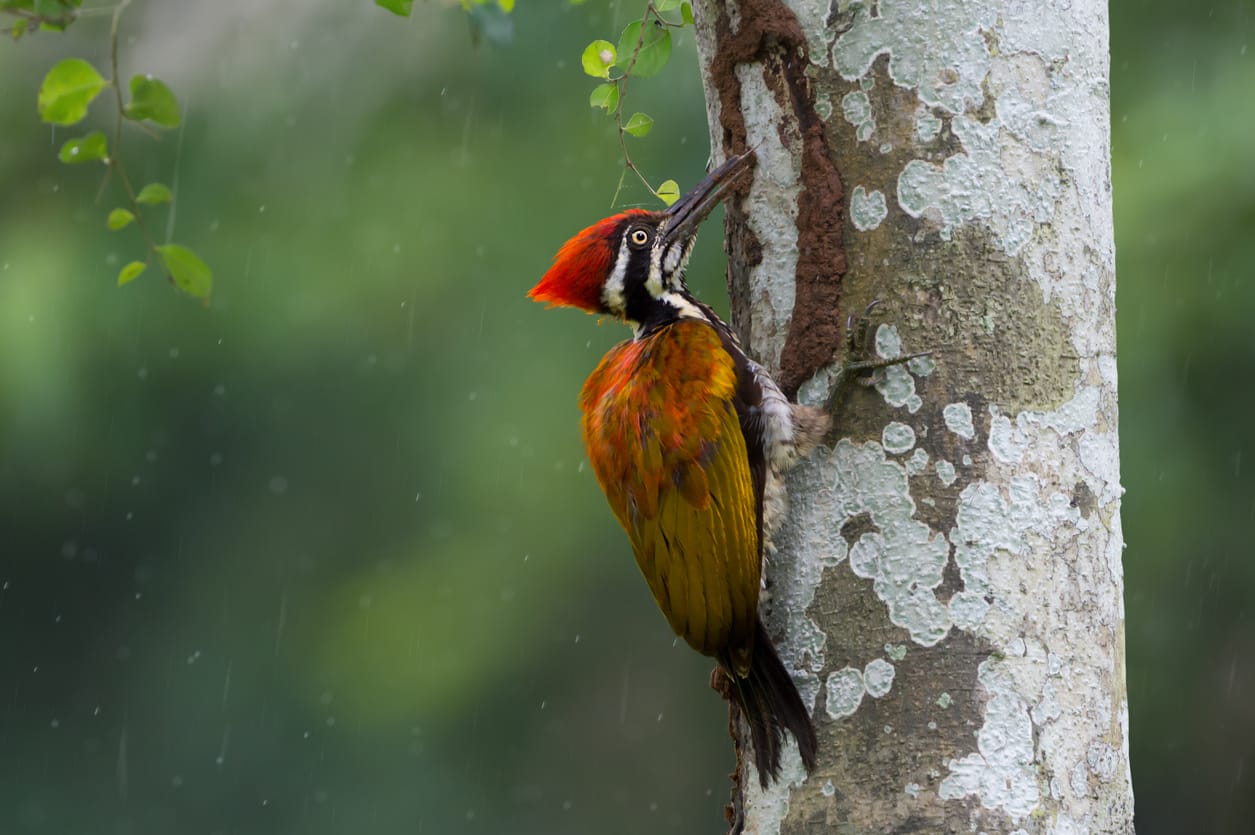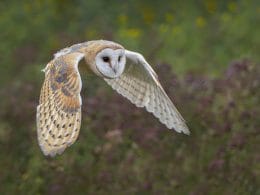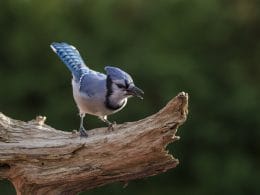Birdwatching can be an exciting adventure, looking out for unique birds that make up the bird-dom of a region. Connecticut is one such region with impressive biodiversity when it comes to different species.
With the state bird being the American Robin, the “Nutmeg State” is a bustling region filled with different habitats. Interestingly, while it has thriving metropolitan areas, almost 61% of Connecticut’s lands are dominated by forests, leading to all kinds of different dwellers.
The area also boasts warm weather when summer is in full bloom, contrasting the snowy winter cold.
This great weather and the aforementioned green landscapes make it perfect for birds to live there all year round. From blue jays to belted kingfishers, Connecticut certainly doesn’t lack in beautiful flying creatures.
In this article, we’re going to take a look at one of them, more specifically, the dazzling woodpeckers. With seven species to potentially see, each has its own distinct characteristics and features. Read on to find out what they are and how you can make them out in the wild.
The 7 Woodpeckers in Connecticut You Need To Keep An Eye Out For
We’ve got some gorgeous birds you can see in the state, so learn more about them below!
1. Pileated Woodpecker

- Scientific name: Dryocopus pileatus
- Length: 15.8 to 19.3inches (40 to 49 cm)
- Weight: 8.8 to 12.3 oz (250 to 350 g)
- Wingspan: 26 to 29.5 inches (66 to 75 cm)
One of the most common woodpeckers in Connecticut it’s also the largest.
The Pileated Woodpecker is instantly recognizable thanks to its large size compared to others in its species.
Having a body similar to that of a crow certainly makes it unique. It also shares some characteristics with them, like a dark black body.
Author Note: They have bold white stripes that run from their beaks, the side of their heads, then down their necks and underwings.
However, their most striking feature is the red flame-like crest on their heads that resembles a mohawk.
The only difference between male and female Pileated Woodpeckers is a red stripe on the cheeks of the males.
Pileated Woodpeckers don’t migrate from the region that often, if at all.
People can see them in a large area of the west coast, parts of Canada, and all of the US eastern coast all year round.
They love to eat carpenter ants, and to reach them, they carve distinct rectangular-shaped holes in trees.
If you ever grew up watching the “Woody the Woodpecker” cartoon, then you’ll know exactly what you’re looking for because it inspired the character’s design.
2. Downy Woodpecker

- Scientific name: Dryobates pubescens
- Length: 5.5 to 6.7 inches (14 to 17 cm)
- Weight: 0.71 to 1 oz (21 to 28 g)
- Wingspan: 9.8 to 11.8 inches (25 to 30 cm)
Smaller in size than a robin, the Downy Woodpecker can be seen all over the USA and Canada all year long.
Not only that, but they’re considered to be the smallest woodpecker in North America overall.
These tiny woodpeckers usually stay where they are and don’t migrate during the winter unless they’re in the freezing north of Canada.
Those usually travel slightly south to warmer temperatures, but they don’t go further south into Latin America like other birds,
Having a mix of black and white in several parts of their body helps them blend in with their surroundings. Both males and females share a striped head, a white belly, checkered wings, and a white stripe down their back.
However, the males are unique by having a red patch on the back of their heads, making them stand out and easily identifiable.
Due to their small size, Downy Woodpeckers mingle with other birds that have the same stature. It’s a way of protecting themselves and having the best probability of finding food.
They also adapted to the presence of humans, so it’s not uncommon to see some of them making their nests in buildings. (Yes, in them, not on them!)
3. Red-Headed Woodpecker

- Scientific name: Melanerpes erythrocephalus
- Length: 7.5 to 9.1 inches (19 to 23 cm)
- Weight: 2 to 3.2 oz (56 to 91 g)
- Wingspan: 16.5 inches (42 cm)
These medium-sized birds have an apt name because what you see is what you get.
Both males and females of the Red-headed Woodpecker have the same features, and they’re gorgeous.
As you might have guessed, they have a crimson-red head, a white body, and black wings.
However, those black wings have a large white patch on them in the middle.
Top Tip: The red-headed woodpeckers are different from most woodpeckers since they not only drill into trees to look for food but can also catch insects in mid-air.
Another thing that makes them unique is that they drill storage holes in trees, where they store excess food like seeds to eat later.
They don’t stop there, though, because they hide these holes by covering them with wood!
Unlike the first two woodpeckers on this list, the red-headed woodpecker isn’t welcoming at all.
Pileated Woodpeckers welcome other birds in their territories during the winter, and Downy Woodpeckers mingle with them, while Red-headed ones are very territorial.
So much so that they’re willing to destroy other birds’ nests and their eggs to force them to leave the area.
4. Red-Bellied Woodpecker

- Scientific name: Melanerpes carolinus
- Length: 9.4 inches (24 cm)
- Weight: 2.0 to 3.2 oz (56 to 91 g)
- Wingspan: 13 to 16.5 inches (33 to 42 cm)
Another medium-sized woodpecker that resides year-round on the eastern seaboard of the USA; it’s a beautiful creature to see in the wild.
Residing in small holes in trees that they make or invading those of others, the Red-bellied Woodpecker is a feisty bird.
The males and females share the same features, including a mostly pale white body with checkered/striped black and white wings.
These characteristics are contrasted by the glaring orangey-red strip that goes all the way from the top tip of their beak to the back of the head and down the nape.
They also have a reddish-hue on their bellies, hence the name, yet it’s really hard to see.
While they prefer eating insects and have an exceptionally long tongue that helps them get them out of crevices, they also like to eat seeds, fruits, and nuts.
Top Tip: Red-bellied Woodpeckers have also been known to eat eggs of smaller birds if they can’t find their usual food.
They’ve even been observed pushing away hummingbirds off of feeders so that they can get nectar too.
Another thing that they like to do is fly erratically in different directions.
This behavior is common because they’re learning how to do evasive maneuvers if they ever find themselves being hunted.
5. Northern Flicker

- Scientific name: Colaptes Auratus
- Length: 11 to 12.2 inches (28 to 31 cm)
- Weight: 3.9 to 5.6 oz (110 to 160 g)
- Wingspan: 16.5 to 20.1 inches (42 to 51 cm)
Found all over the USA, the Northern Flickers are a very common breed.
Even though they don’t have woodpecker in their name, they’re part of the same family.
The Northern Flickers have a slightly curved beak that helps them find and dig for their favorite food. Yes, you read that right, dig, because the bird loves to eat ants and beetles!
That’s why people get surprised seeing them on the ground, but they’re mostly looking for their food.
Both sexes are light-brown in color but have black-dotted/scalloped plumage as well.
They also have a black bib-like half circle on their chest and a red stripe on their head.
Interestingly, there are two breeds of this woodpecker living in the US.
One breed has red feathers in its wings and resides in the west, while the other has yellow feathers and resides in the east.
The Northern flicker tends to move around, especially when breeding, since most of them migrate to the north to do so.
However, once winter starts to creep in, they migrate from that area going south, as far down as Cuba and Mexico.
While not as big as the Pileated Woodpeckers, the Northern flickers are bigger than most of the other species.
6. Yellow-Bellied Sapsucker

- Scientific name: Sphyrapicus varius
- Length: 7.1 to 8.7 inches (18 to 22 cm)
- Weight: 1.5 to 1.9 oz (43 to 55 g)
- Wingspan: 13.4 to 15.8 inches (34 to 40 cm)
From their name, you can figure out what Yellow-bellied Sapsucker’s favorite food is going to be.
The Yellow-bellied Sapsucker is a small bird that loves to drill into trees with its straight beak in search of sap or any insects that might be stuck on it.
Their consistent reveal of sap actually benefits other birds, including Ruby-throated Hummingbirds, which enjoy it too.
Both sexes of these woodpeckers have white bodies accented with some black hues, and their wings are checkered with the same colors.
Like the northern flicker, they also feature a black bib, but theirs tops a slightly yellow chest.
Author Note: While both the males and females have a deep red forehead that tips to the top of their head, only the males have similarly red throats.
Unlike the rest of the woodpeckers on the list, the yellow-bellied sapsuckers are the only ones that are completely migratory.
Most of them stay on the east coast throughout the year, yet during winter, they migrate south, going as far as Mexico, Cuba, and Panama.
7. Black-Backed Woodpecker

- Scientific name: Picoides arcticus
- Length: 9.1 inches (23 cm)
- Weight: 2.1 to 3.1 oz (61 to 88 g)
- Wingspan: 15.8 to 16.5 inches (40 to 42 cm)
Unlike the rest of the woodpeckers on the list, the Black-backed Woodpecker is rare to find. However, that doesn’t mean that there isn’t a chance you could see one.
These woodpeckers are usually found in the north of the continent, covering areas from Connecticut to as far northwest as Alaska.
The Black-backed Woodpeckers are inky black all over with a white belly, contrasted by a white stripe across their face.
The males are easily distinguishable because they have a bright yellow crown on their foreheads.
Top Tip: Their specialty is a bit morbid. They tend to go into burnt forests and start looking for wood-boring beetle larvae as well as other insects.
The Black-backed Woodpeckers are among the few of their species that have three toes on each foot instead of four; that’s why they’re also called the Arctic Three-toed Woodpecker.
How to Bring Woodpeckers Into Your Backyard?
Some people love seeing woodpeckers up close, and it’s easy to understand why; it’s all thanks to their beauty and their interesting habits. You can never get bored watching woodpeckers drill into wooden trunks.
An easy way to do that is to leave any dead or dying trees that you might have in your backyard. Woodpeckers will most likely come and peck at it, foraging for food and likely to nest there too.
You can also attach nest boxes if you don’t have any; just make sure it’s high up and ready for them before the breeding season begins.
Bird feeders are also an efficient way to get them to come closer to your home, especially ones that offer suet, peanuts, and foods that woodpeckers prefer.
Conclusion
Woodpeckers are fascinating birds to watch; they’re magnificent to look at. So it comes as no surprise that people set out to find them.
There are several places where you can go on an adventure and look for these woodpeckers in the wild.
As we mentioned earlier, almost 61% of Connecticut is covered in forests, so it’s going to be perfect for anyone looking to do some bird watching this summer.
Just remember to prep before going out there, and bring your binoculars too! We hope you enjoyed our guide on woodpeckers in Connecticut.
FAQ
Some great places to start planning your woodpecker trip are These places include East Rock Park, Harkness State Park, Cockaponset State Forest, Nehantic State Forest, and the Yale-Myles Forest.
To find out where recent sightings of woodpecker have been, try eBird. You can search for the latest sightings or particular species or what has been seen in a certain area.
The Pileated Woodpecker is one of the most common woodpeckers in Connecticut.










